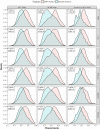EMT network-based feature selection improves prognosis prediction in lung adenocarcinoma
- PMID: 30703089
- PMCID: PMC6354965
- DOI: 10.1371/journal.pone.0204186
EMT network-based feature selection improves prognosis prediction in lung adenocarcinoma
Abstract
Various feature selection algorithms have been proposed to identify cancer prognostic biomarkers. In recent years, however, their reproducibility is criticized. The performance of feature selection algorithms is shown to be affected by the datasets, underlying networks and evaluation metrics. One of the causes is the curse of dimensionality, which makes it hard to select the features that generalize well on independent data. Even the integration of biological networks does not mitigate this issue because the networks are large and many of their components are not relevant for the phenotype of interest. With the availability of multi-omics data, integrative approaches are being developed to build more robust predictive models. In this scenario, the higher data dimensions create greater challenges. We proposed a phenotype relevant network-based feature selection (PRNFS) framework and demonstrated its advantages in lung cancer prognosis prediction. We constructed cancer prognosis relevant networks based on epithelial mesenchymal transition (EMT) and integrated them with different types of omics data for feature selection. With less than 2.5% of the total dimensionality, we obtained EMT prognostic signatures that achieved remarkable prediction performance (average AUC values >0.8), very significant sample stratifications, and meaningful biological interpretations. In addition to finding EMT signatures from different omics data levels, we combined these single-omics signatures into multi-omics signatures, which improved sample stratifications significantly. Both single- and multi-omics EMT signatures were tested on independent multi-omics lung cancer datasets and significant sample stratifications were obtained.
Conflict of interest statement
The authors have declared that no competing interests exist.
Figures




Similar articles
-
Development and validation of a transcription factor regulatory network-based signature for individualized prognostic risk in lung adenocarcinoma.Int J Cancer. 2025 Jun 15;156(12):2440-2451. doi: 10.1002/ijc.35375. Epub 2025 Feb 17. Int J Cancer. 2025. PMID: 39960662
-
Multi-omics facilitated variable selection in Cox-regression model for cancer prognosis prediction.Methods. 2017 Jul 15;124:100-107. doi: 10.1016/j.ymeth.2017.06.010. Epub 2017 Jun 13. Methods. 2017. PMID: 28627406
-
KRT8 and KRT19, associated with EMT, are hypomethylated and overexpressed in lung adenocarcinoma and link to unfavorable prognosis.Biosci Rep. 2020 Jul 31;40(7):BSR20193468. doi: 10.1042/BSR20193468. Biosci Rep. 2020. PMID: 32519739 Free PMC article.
-
The Application of Bayesian Methods in Cancer Prognosis and Prediction.Cancer Genomics Proteomics. 2022 Jan-Feb;19(1):1-11. doi: 10.21873/cgp.20298. Cancer Genomics Proteomics. 2022. PMID: 34949654 Free PMC article. Review.
-
Towards multi-omics characterization of tumor heterogeneity: a comprehensive review of statistical and machine learning approaches.Brief Bioinform. 2021 May 20;22(3):bbaa188. doi: 10.1093/bib/bbaa188. Brief Bioinform. 2021. PMID: 34020548 Review.
Cited by
-
CT-based radiomics for predicting lymph node metastasis in esophageal cancer: a systematic review and meta-analysis.Front Oncol. 2024 Mar 19;14:1267596. doi: 10.3389/fonc.2024.1267596. eCollection 2024. Front Oncol. 2024. PMID: 38577325 Free PMC article.
-
UBE2L3 promotes lung adenocarcinoma invasion and metastasis through the GSK-3β/Snail signaling pathway.Am J Transl Res. 2022 Jul 15;14(7):4549-4561. eCollection 2022. Am J Transl Res. 2022. PMID: 35958458 Free PMC article.
-
A chimeric virus-based probe unambiguously detects live circulating tumor cells with high specificity and sensitivity.Mol Ther Methods Clin Dev. 2021 Aug 28;23:78-86. doi: 10.1016/j.omtm.2021.08.007. eCollection 2021 Dec 10. Mol Ther Methods Clin Dev. 2021. PMID: 34631928 Free PMC article.
-
A novel single-cell based method for breast cancer prognosis.PLoS Comput Biol. 2020 Aug 24;16(8):e1008133. doi: 10.1371/journal.pcbi.1008133. eCollection 2020 Aug. PLoS Comput Biol. 2020. PMID: 32833968 Free PMC article.
-
Prediction of an outcome using NETwork Clusters (NET-C).Comput Biol Chem. 2021 Feb;90:107425. doi: 10.1016/j.compbiolchem.2020.107425. Epub 2020 Dec 8. Comput Biol Chem. 2021. PMID: 33360198 Free PMC article.
References
-
- Lapointe J, Li C, Higgins JP, Van De Rijn M, Bair E, Montgomery K, et al. Gene expression profiling identifies clinically relevant subtypes of prostate cancer. Proceedings of the National Academy of Sciences of the United States of America. 2004;101(3):811–816. 10.1073/pnas.0304146101 - DOI - PMC - PubMed
Publication types
MeSH terms
Substances
LinkOut - more resources
Full Text Sources
Medical

